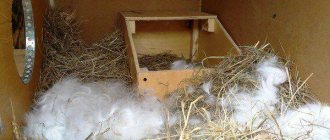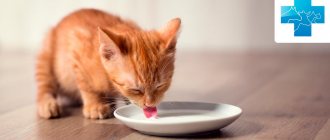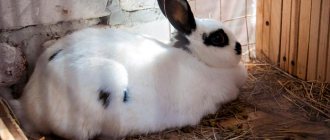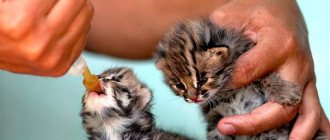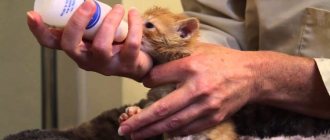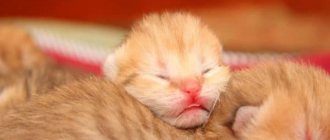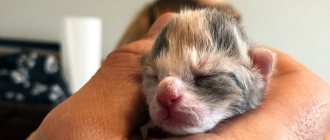Breeding rabbits is an interesting and profitable business. But alas, it’s also quite troublesome. The period of birthing and raising rabbits is considered especially problematic.
It happens that during or after birth a female rabbit dies, or for a number of reasons she simply refuses to feed her offspring. Then the helpless newborn rabbits are left without mother's milk and can quickly die. In order for the babies to survive, the breeder must take care of feeding the offspring.
Why are baby rabbits left without mother's milk and care? What is the danger?
The decision in favor of artificial feeding is made by the farmer for one of the following reasons:
- Having barely given birth, the female refuses the rabbits and abandons them;
- the rabbit has no milk or has developed mastitis;
- the female is in very serious condition after giving birth or has died;
- another nurse does not accept babies.
It is especially dangerous for rabbits when the female dies before she has time to feed them valuable colostrum for the first time. It contains antibodies necessary for babies, which contribute to the development of their own immunity.
Human care and concern cannot replace the mother's cubs, and incorrect actions on the part of breeders increase the mortality rate.
Decorative rabbits have less chance of survival, and meat breeds, even when artificially fed, grow up to be healthy, strong individuals.
Is it possible to do without a rabbit?
Newborn rabbits are still naked and spend the first days under the mother's cover, continuously sucking at the breast. A two-week-old rabbit is already covered with soft short fluff and begins to crawl out of the nest.
The question of how to feed baby rabbits without a female rabbit at 14 days of age does not even arise for the farmer. The babies are already partially switching to food intended for their mother. But how to feed a very small suckling if there is no mother nearby?
Additional Information. With a large litter, breeders in this situation select some of the rabbits weighing at least 60 g and transfer them to biofarms. They mostly get rid of the males. The remaining children on the farm try to go out on their own.
What to try before artificial feeding?
The purpose of artificial feeding is not only to ensure that the rabbits are well-fed, but also to provide comprehensive care for the offspring. Before you begin your duties, try the following alternatives:
- Find a nurse for the offspring. This course of events is possible if the breeder has several queens. You cannot simply place the baby rabbits with another lactating female. There is practically no chance that she will accept someone else's offspring. Therefore, put the rabbit in another cage for half an hour, and wipe the babies with fluff and straw from her home. The nurse will return to the cage and will probably accept new charges.
- Awaken your parental instinct. Most often, it is after the first birth that a mother does not want to feed her babies. Try to solve this problem by simply holding your rabbit during several feeding sessions.
If the outcome is favorable, feeding on mother's milk, the baby rabbits will quickly get stronger and begin to gain weight. But it happens that these tips do not help.
Okrol
A rabbit's pregnancy lasts 28–31 days. A week before giving birth, the female begins to prepare for it. She tears the fluff on herself, fusses, drags hay into the queen cell. Inexperienced female rabbits do not always take care of arranging the nest. If the expectant mother is not busy preparing for the birth, the farmer should do this instead:
- install the queen house in the cage;
- pluck the rabbit's fluff in the chest and abdomen;
- Place a bedding of straw and down in the nest.
The breeding usually begins in the evening or at night. No human help will be needed. The female will do everything herself. Within 30–60 minutes, all the rabbits will be born.
Attention! After giving birth, a rabbit needs plenty of clean drinking water. If she is not in the drinking bowl, the female can destroy the offspring.
The breeder's task is to provide peace for the rabbit family. It is best to place the cage in a safe, quiet place so that mother and babies are not stressed by loud noises. There should be no draft in the room.
How to feed baby rabbits correctly for the first 30 days?
Rabbits are born completely blind, without fur. The first fluff on the body begins to grow on the 6th day, and the opening of the eyes occurs on the 10th day. Newborns weigh 60-90 g, but with comprehensive care and proper nutrition, they quickly gain weight and grow.
The farmer should prepare for artificial feeding of the offspring - master care skills and purchase equipment.
Tools
Feeding rabbits requires nipples and containers.
Buy an animal feeding kit . It includes a special syringe with rubber nozzles of different shapes and sizes. This set is sold in the form of a bottle with several special nipples.
You can get by with improvised means:
- Use a syringe and a rubber pipette attachment , making several small holes in it.
- A bottle of eye drops is suitable for performing the procedure . For convenience, use it with a pipette tip.
- baby bottle is useful for older animals.
The process of artificial feeding should be as similar as possible to natural feeding.
Before their eyes open, the reaction of baby rabbits to nipple substitutes is weak. When pouring milk into the mouth, be careful and take your time, otherwise the baby rabbit may choke or choke.
Milk substitutes
Newborn rabbits require high-quality, nutritious nutrition. Rabbit milk substitutes include:
- Goat milk. The best option for artificial feeding of rabbits. There is no need to dilute or add anything, because the composition is similar to rabbit milk, only slightly inferior in fat content.
- Cow's milk. The most affordable and common option for replacing rabbit milk. In its pure form, it cannot be fed to babies, because it does not contain enough carbohydrates. Mix cow's milk with condensed milk in a 3:1 ratio. Heat the mixture for 40-60 minutes. at a temperature of 70. Before feeding, cool to 37 degrees.
- Special mixtures. Sold in pet stores and veterinary pharmacies in a large assortment. Buy milk replacers designed for feeding rabbits or dogs. As a last resort, cat food is suitable. In terms of components, their composition is as similar as possible to rabbit milk.
- Infant milk formulas . This food is suitable for rabbits if it contains a minimum of sugar and additives.
In this video you can see the principle of artificial feeding of baby rabbits:
Thus, the most suitable food for newborn rabbits is special dry mixtures, and cow's milk is the least preferred option.
Feeding procedure
During the procedure, hold the animals upright, firmly, but not squeezing. At first, baby rabbits may not respond to simulated nipples. Be patient.
Gently wet your baby's mouth with milk and he will lick it off. Repeat several times. This will stimulate the sucking reflex.
During the feeding procedure, be careful that liquid does not enter the animal’s respiratory tract. This is fraught with the death of the little rabbit.
Make sure that the tummy does not become full, because babies themselves cannot yet determine their level of satiety. When overeating, stomach upsets occur and related problems appear.
The feeding liquid should be 37 degrees. Store milk in the refrigerator for up to 3 days, and always use freshly prepared formula for feeding.
Build a diet according to the needs of the cubs. Well-fed babies sleep quietly, while hungry babies squeak and actively search for a source of food.
Dosage and frequency
The amount of mixture and the frequency of feedings directly depend on the age of the rabbits.
The female feeds the rabbits 1-3 times a day. Her milk is very nutritious; so many feeding sessions are enough for the rabbits to develop properly, grow and gain weight.
But no formula replaces rabbit milk, so bottle-fed babies are fed up to 6 times a day.
In the first 2 days, baby rabbits only need a few drops of food per dose; even 1 ml of the mixture is too much for them.
Gradually, the amount of milk required for the development of cubs increases, and the number of feedings decreases.
Artificial feeding by age
Organizing artificial feeding is a responsible matter. You need to be extremely careful when choosing a diet for baby rabbits, depending on their age and physical health. After all, errors in the quantity and quality of the diet have a detrimental effect on the cubs.
From birth to 5 days
A newborn rabbit needs 1 drop of nutritional liquid. During the first day they feed 5-6 times. Since babies have not yet learned to swallow on their own, you need to be careful.
On the second day, 4-5 meals are enough. On day 5 - 4 feedings. The daily milk intake is 5-6 ml. By the end of this period, rabbits with normal development double their weight.
From 6 to 14 days
Animals grow up and the amount of nutritional mixture per feeding increases. They drink 7-10 ml of milk per day. The number of feedings remains the same or is reduced to 3. The weight of the baby rabbits reaches 250 g.
From 15 to 30 days
From the 15th day the animals are transferred to two meals a day. In the first 2-3 days, observe the behavior of the young animals and, if signs of hunger are present, feed them with a small amount of mixture at the 3rd feeding.
The amount of mixture per day by the end of the month reaches 60 ml. This is their main diet for now. You should wean off the pacifier within 20-25 days.
Readiness to introduce complementary foods is determined by the condition of the teeth. If molars have replaced milk teeth, then you can gradually introduce solid food and teach you to drink from a saucer.
The weight of animals by the end of the period reaches approximately 500 g.
| Development period of baby rabbits | Number of feedings per day, times | Mixture rate for 1 feeding per 1 individual, ml |
| From birth to 5 days | 5 | 1 |
| From 6 to 14 days | 3-4 | 7-10 |
| From 15 to 30 days | 2-3 | 60 |
How to replace rabbit milk?
It is recommended to feed newborn rabbits with high-quality substitutes. This is the only way they can receive the maximum amount of nutrients.
Valid options are:
Goat milk
Natural, fresh, it has an identical composition to rabbit. The only difference is a little less fat content. It does not need to be mixed with anything or diluted;
Milk substitute mixtures
Veterinary stores and pharmacies sell various mixtures for feeding animals. Milk replacers are best suited directly for rabbits and for dogs.
In second place are cat species. Their composition is also not far from the native milk of eared animals. Nutrients are perfectly absorbed;
Baby food
Formulas for human infants are acceptable if they contain a minimum of sugar and additives. In today's wide range of products, it is not difficult to find such milk powder.
When it comes to cow's milk, opinions differ. Some farmers consider it categorically unacceptable for rabbits. Other breeders argue that such a replacement is possible when there are no other options.
Cow's milk differs significantly from rabbit's in composition, fat content, and ability to be absorbed. In its pure form, it does not satisfy the needs of small rabbits.
Some suggest mixing whole cow's milk with condensed milk (preferably without sugar) 4 to 1. But this mix is considered an emergency.
Introduction of fertilizing
Starting from the third week, place small piles of dry grass in the cage - this will prepare the rabbits for solid food.
At this time, it is important to monitor changes in the baby's stool. If diarrhea occurs, remove hay from the diet immediately. If adaptation to new food goes without problems, then add a small amount of feed, grass, and carrots.
From the 31st day, if there is no weight loss, milk is gradually removed from the rabbits' diet. When the offspring turn 45 days old, their diet completely switches to that of an adult.
Vitamin A and Vitamin D
In nature, rabbits receive the necessary vitamins and minerals from their mother’s milk, and then from a varied adult diet. Artificially fed individuals require larger amounts of vitamin supplements.
If the body lacks vitamin A , then rabbits suffer from a runny nose and dry eyes. This vitamin is responsible for the desire to reproduce and have healthy offspring, as well as the healthy functioning of the nervous system. Its sources are: beet tops, carrots, cabbage leaves, young grass, etc.
Vitamin D is responsible for the formation of bone tissue. If it is deficient, growth retardation and various deformities of the limbs and spine are possible. Vitamin D is produced by the body itself under the influence of sunlight. Bone meal, fish oil, and milk will help with this. Feed foods in places where the sun's rays do not have access, as vitamin D is destroyed under their influence.
Oatmeal and oat sprouts
Oats are a fundamental grain in the diet of rabbits, containing a whole storehouse of vitamins and microelements. Its calorie content is 336 kcal/100 g. It can occupy up to 50% of the total mass of feed. Rabbits gain weight well on this food, but oats do not cause obesity.
This cereal is introduced into the diet of rabbits as soon as they begin to feed on their own. First, they are fed with oatmeal or crushed grain, and then they switch to feeding whole grains.
Animals happily eat this food up to 5 times a day, and adults - 3 times a day.
Oat sprouts have a good effect on the reproductive system of rabbits. For mating, it is introduced into the diet of both males and female rabbits. Oats help nursing females recover after giving birth and stimulate the production of nutritious milk.
Sprouted oats are rich in beneficial substances that have a beneficial effect on the gastrointestinal tract of animals. Appetite increases, fur becomes beautiful and shiny, body weight increases.
Be sure to put a drinking bowl in the cage if dry cereal food predominates in the rabbits' diet.
Bone meal and chalk
Bone meal is a powder made from the bones of animals and birds, a valuable source of calcium, phosphorus, fluorine, zinc, iron, protein and other micro- and macroelements.
By introducing it into complementary foods, the likelihood of diseases associated with the musculoskeletal system in rabbits is significantly reduced. Thanks to proteins, the muscle mass of animals grows faster.
The doses indicated on the packaging of bone meal must be strictly followed. An overdose is even more dangerous than the problems associated with the absence of this bait:
- The stomach of rabbits becomes clogged with a jelly-like mass, which is why the animals often die.
- Females become aggressive and lose their ability to reproduce.
- There are cases of cannibalism among individuals.
If the beginnings of these problems appear, reduce portions or remove flour from your diet.
Chalk is a safe mineral supplement that supplies calcium to the body. Can be used in powder form, in lump form and in mineral briquettes. Chalk is useful for the prevention of bone tissue diseases.
Branches and acorns
Branches of trees and shrubs are used not only as food. Some are useful for preventing illnesses.
For example, walnut branches remove parasites from the body, linden and willow branches work as an anesthetic, birch branches act as a diuretic. They are given to rabbits infrequently, as needed.
Trees and shrubs whose branches can be used as constant complementary food include:
- Apple tree, acacia, poplar, hazel, ash, linden, maple, aspen, mulberry, etc.
- Raspberries, currants, grapes.
Trees whose branches can be given to rabbits occasionally :
- Pear, rowan, oak, chestnut.
- Pine, juniper.
Branches of bird cherry, lilac, elderberry, and wild rosemary should not be used in the diet.
Acorns are another nutritious food for rabbits. They can be fed both green and dry. The norm of acorns per day for an adult is 50 g.
Introduce them into the diet gradually - first in the form of flour, as an additive to the main grain feeds, and then as an independent complementary food. Rabbits love to chew on them.
For more information, read our article on how, when and what to feed rabbits.
Table salt
Table salt is used not only as a seasoning. Chlorine ions contribute to the production of hydrochloric acid in the gastric juice, and sodium ions are responsible for the transmission of nerve impulses.
Rabbits chew wooden partitions in their cages due to salt deficiency. This indicates the following problems:
- violation of metabolic processes;
- decreased productivity of offspring, increased number of miscarriages;
- slow growth of newborn animals;
- gastrointestinal diseases;
- water-salt imbalance and diseases associated with blood formation.
Table salt is usually given in combination with chalk. For this, mineral briquettes . The following components will be required:
- 500 g of feed chalk;
- 500 g red clay flour;
- 300 g flour of crushed hardwood charcoal;
- 5 tbsp. l. salt;
- 3 tbsp. l. feed sulfur.
Mix the ingredients with water to form a thick dough. Make shapes the size of a matchbox from it. Thread them onto a wire. Dry first in the shade and then in the sun. Fire it like clay in a kiln.
Place one in each rabbit cage. They themselves will learn to chew the briquette in the quantity that their body requires.
Acidophilus
Rabbits are not known for their good health; the gastrointestinal tract is their weak point. Gastrointestinal stasis is often found in these animals, when the stomach stops working and the individual dies.
Acidophilus is a complex of beneficial lactobacilli. It helps digest food in the large intestine and protects against harmful bacteria, the growth of which leads to bloating, diarrhea and other troubles.
This drug will also help when taking antibiotics, when all intestinal microflora is destroyed.
When do rabbits start eating on their own?
Immediately after leaving the nest, the babies begin to taste food from their mother's feeder. It is not entirely suitable for feeding, so farmers install separate dishes for the cubs.
At the age of 20 days, rabbits can be given:
- grated carrots;
- grass in the form of granules;
- fresh soft hay;
- sprouted grain.
Attention! The digestive system of small rabbits is weak. New foods are introduced carefully, offering them in small portions. It is important to monitor your pet’s body’s reaction.
At two months of age, rabbits completely switch to adult food. Their diet becomes varied and includes:
- hay;
- fresh herbs;
- twig food;
- grains and legumes;
- vegetables.
What are caecotrophs, why are they needed and where to get them?
Caecotrophs are the primary feces of rabbits. It has an oblong shape, often resembling a bunch of grapes due to the sticky pellets. Color varies from light green to black. The smell is unpleasant, sour.
This feces are formed in a special compartment of the cecum, which is found only in lagomorphs. Therefore, do not confuse caecotrophs with regular feces.
Typically, rabbits eat caecotrophs from the age of 20 days as soon as they leave the body. This way they re-absorb vitamins and minerals. Without this, animals would suffer from vitamin deficiency.
If there are too many caecotrophs, the animal does not eat them, which means you are overfeeding the rabbit with grains. Remove grains from the diet for a couple of days, leaving water, branches and hay.
The second reason may be worms. Fight the parasites and everything will return to normal.
Feeding
With mother's milk, babies receive the necessary nutrients. It will be more difficult to feed baby rabbits without a mother rabbit. Pets will also need high-quality and healthy nutrition.
If the owner uses a specialized artificial milk replacer from a pet store, there is no need to worry. Such products often include a complex of essential nutrients. But if little rabbits deprived of their mother are fed other foods, the diet will have to be diluted with the following foods:
- Fish fat. You can buy such a product at a pharmacy. Just a few drops added to a container of milk will strengthen the immunity of small pets. Vitamins A and D contained in fish oil have a positive effect.
- Sprouted oats or oat flour. These products contain dietary fiber and vitamins. Flour for babies is used as a supplement from days 5 to 14 of their life. Later it is replaced with sprouted grain.
- Table salt. This product is added in small quantities (no more than 0.5 g per day). Feeding salted food to pets is allowed from the age of one month.
- Chalk. An essential mineral for rabbits. It is added to the diet from 3-4 weeks of life.
- Tree branches. Small annual shoots of birch and conifers are suitable. The products are rich in vitamin C. The branches will allow you to raise rabbits with strong teeth.
- Caecotrophs. This is a litter of adult rabbits with a lot of vitamins and minerals. Add 2-3 peas per serving of hay or vegetables.
Olga Nevolina (Veterinarian):
In the first days, the female rabbit feeds the offspring with colostrum, which contains a large amount of antibodies that protect babies from a number of diseases. Unfortunately, no supplement will provide this. Naturally raised rabbits are treated with special attention.
The acidophilus supplement will help raise healthy little rabbits. This product contains a complex of bacteria beneficial for digestion. It is often sold in pet stores in liquid form. By adding two drops of acidophilus to the dish daily, you will be able to normalize the digestion of a small rabbit at a week old.
Advantages and disadvantages of human feeding rabbits
Artificial feeding of rabbits has its positive and negative sides.
Benefits include:
- Getting used to milk substitutes, rabbits are unpretentious to food.
- A good appetite leads to weight gain and growth of individuals.
- The diet is adjusted to the person and his capabilities.
Disadvantages of artificial feeding:
- The nutritional value, composition of vitamins and minerals in the substitutes is significantly lower than in natural rabbit milk.
- The inability to transfer antibodies, which means weakened immunity of the offspring.
- Difficulty in pacifier training.
- The baby rabbit may be injured during feeding.
- Constant presence of a person next to the children for care and attention.
Required amount of food per newborn during feeding
Goat's milk is suitable for feeding baby rabbits.
The young rabbit will face serious challenges from the first minutes of his life. And the main danger in this case is insufficient weight gain. If natural feeding is impossible, measures are taken to provide artificial nutrition to newborn animals.
Normal development of rabbits is ensured by the consumption of 4 to 5 ml of milk or mixture within 24 hours. The daily dose is distributed over several feedings, and their frequency depends on the animal’s ability to accept the food offered. Excessive amounts of mixtures cause a full stomach and lead to poor health in the newborn animal.
The release of milk after giving birth depends on the quality of feed consumed by the female. If milk production is weak, it is necessary to add to the animal’s diet an amount of feed that will increase its production.
During the period of feeding newborn rabbits, a female consumes from 50 to 270 g of milk. A female rabbit's milk production increases until the 20th day of birth, and from the 25th day of feeding, the amount of milk decreases.
The milk secreted by the female for feeding the rabbits contains high-quality fats, proteins, mineral salts, and dry substances. Pets quickly gain weight: their weight increases significantly on the 6th day after birth.
The volume of milk required for one feeding increases as the baby rabbit grows. Complementary foods consisting of ingredients such as:
- grated carrots,
- hay,
- dry feed mixtures.
When replacing dry feed with green grass, the daily amount of food should not exceed 50 g. Young animals under the age of 4 months receive 100-800 g of green feed. Fattening of weak individuals lasts 3-4 weeks, and the pet’s diet consists of green food in the amount of 300-400 g, as well as concentrates weighing 20-30 g.
Source: 1pokrolikam.ru
Caring for baby rabbits
The sooner the rabbits are left without a uterus, the more complex care they need. Living conditions and feeding regime require great responsibility and dedication from a person.
Lighting and heat
Newborn rabbits require special care; attention should be paid to lighting and warmth when raising babies.
There must be a place in the cage where the sun's rays do not reach. Direct solar radiation is dangerous for animals. Daytime lighting should be dim, and at night it is recommended to turn off the lights.
The rabbits should be warm. To do this, build a nest from the fluff of adult rabbits or place a heating pad in the cage. The optimal temperature is when a person's hand is comfortable, not hot.
Hygiene
Cleanliness when caring for rabbits is necessary, because without immunity they are more susceptible to germs and bacteria.
Boil dishes and teats before use. Prepare mixtures before feeding according to instructions. Store milk in the refrigerator for no more than 3 days.
Before feeding, wash your hands with fragrance-free soap and dry with a towel. After feeding, clean your babies of any leftover food and feces.
Abdominal massage
Emptying the bowel and bladder requires special attention, because babies do not know how to cope with it.
Before feeding, the female licks the baby rabbit, pressing on the belly with her tongue, moving from the navel to the hind legs. Thus, it forces the intestines and bladder to empty.
A person who replaces a mother for rabbits should not forget about this procedure. Otherwise your bladder will burst.
Before each feeding, it is necessary to massage the baby rabbit's abdomen with a damp soft rag or a piece of cotton wool.
This manipulation is completed when the offspring are more than 14 days old.
Healthy rabbits have a firm and slightly convex belly. If it is sunken, then this is a sign of gastrointestinal problems.
In the video below, the breeder clearly shows how to massage a rabbit’s belly before feeding:
Caring for orphaned rabbits requires a lot of strength, skills and patience. This is the only way they will survive and grow into beautiful, healthy individuals.
0
0
Copy link
Substitution procedure
Female rabbits easily accept other people's offspring and do not worry that their babies smell like humans. But the substitution procedure should be carried out in such a way as to avoid excesses. First of all, remove the female from the cage. You can distract her with her favorite treat so that she is not eager to return to the cubs.
Fake rabbits are placed in the center of the nest and covered with down. After this, the female is returned to the cage and her behavior is observed. Most likely, the replanting will go well, and the new mother will take care of the babies as if they were her own. If this does not happen, switch to artificial feeding.
Afterword
Artificial feeding, a forced option for feeding rabbits, does not always bring the desired result, especially for novice rabbit breeders. Meanwhile, it should be used, since time and money costs not only pay off, but also bring additional profit, and with the acquisition of experience, efficiency will only increase. This method is used even on large rabbit farms. The probability of successful feeding of rabbits, starting from the age of five days, is almost one hundred percent. I wish you success and good luck in further increasing your herd.
Dry substitutes
Artificial feeding of rabbits is based on dry mixtures. You can buy them at a pet store or veterinary pharmacy. If possible, you should choose substitutes for rabbit milk directly. But options for dogs or cats are also suitable.
Baby formulas are less suitable for rabbits , but they can also be used if there is no other option. The main thing is to give your kids ones that contain a minimal amount of sugar. The advantage of this option is a wide range.
Unfortunately, lately it has been very difficult to find high-quality foreign milk substitutes for babies, and there are not many domestic options. Therefore, rabbit breeders give preference to baby dry formulas, since they can be purchased at any store.
